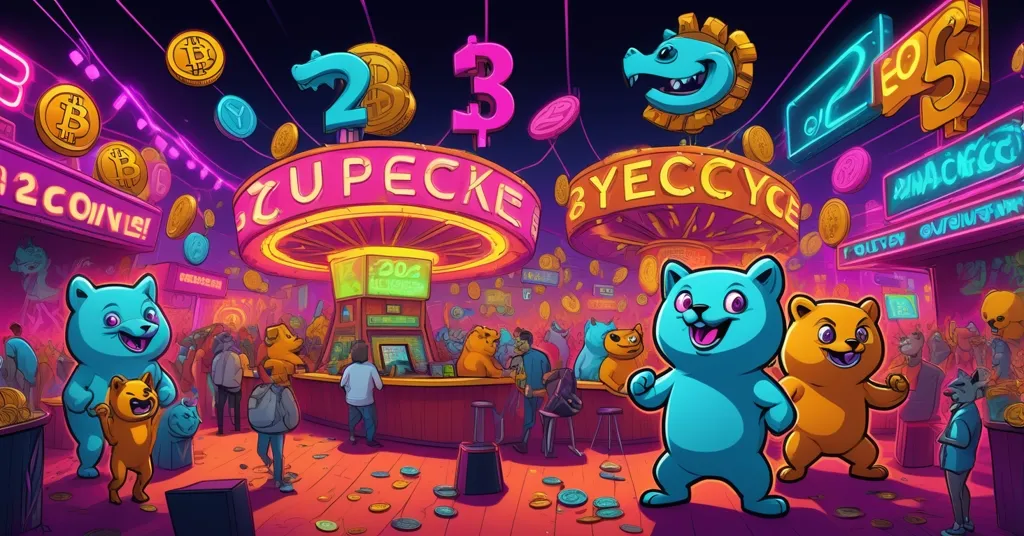8 Meme Coins for 2025-26 Supercycle: Hype or Hazard for Crypto Investors?

8 Meme Coins Pitched for the 2025-26 Supercycle: Hype, Hope, or Hazard?
As the crypto world gears up for a potential 2025-26 “supercycle”—a massive wave of gains tied to the 2024 Bitcoin halving—meme coins are stealing the show with promises of life-changing returns. But are these internet-fueled tokens, often built on little more than jokes and viral buzz, a genuine opportunity or a disaster waiting to happen? We’re diving deep into eight meme coins touted as must-buys for the coming bull run, slicing through the hype with a no-nonsense look at their potential and pitfalls.
- Supercycle Buzz: Forecasts of 40x-100x returns for meme coins in 2025-26, tied to Bitcoin’s halving and retail mania.
- Tokens in Focus: Little Pepe ($LILPEPE), Pudgy Penguins ($PENGU), Dogwifhat ($WIF), Floki ($FLOKI), Bonk ($BONK), Fartcoin ($FARTCOIN), Turbo ($TURBO), Toshi ($TOSHI).
- Reality Check: Weighing viral appeal against inflated projections, token risks, and market traps.
The Supercycle Hype: Fact or Fantasy?
Every few years, the crypto market gets swept up in talk of a “supercycle”—a period of explosive growth often triggered by Bitcoin’s halving, an event roughly every four years that cuts mining rewards in half, reducing new supply and historically sparking price surges. The next halving, set for 2024, has speculators eyeing 2025-26 as the peak of the next bull run. Past cycles tell a story: post-2012 halving, Bitcoin soared from $12 to over $1,000; after 2020, it rocketed from $10,000 to $69,000. Meme coins, riding the coattails of retail fear of missing out (FOMO) and whispers of institutional money pouring in, are pitched as the wildcards that could multiply investments 40 to 100 times over. Macroeconomic factors, like low interest rates or inflation fears, might further fuel this fire, pushing investors toward riskier assets like crypto. For insights into how halvings influence these speculative tokens, check out this analysis on Bitcoin halving impacts on meme coins.
But let’s pump the brakes. While historical patterns offer some basis for optimism, they’re no guarantee. Every bull run has been followed by a brutal crash—Bitcoin dropped 80% after its 2017 peak, and meme coins often fare worse. Global economic downturns, tighter monetary policies, or aggressive regulatory moves could easily derail this so-called supercycle before it even starts. And when it comes to meme coins, the lack of hard data behind these 40x-100x predictions—often just guesses from unnamed “analysts”—should have any sane investor raising an eyebrow. Hype is a dangerous drug, and in crypto, it’s often the latecomers who overdose.
Meme Coins 101: Why They Matter (and Why They Don’t)
For the uninitiated, meme coins are a bizarre corner of the crypto space. Unlike Bitcoin, which aims to be decentralized money free from government control, or Ethereum, which powers smart contracts and decentralized apps (dApps), meme coins are typically built on little more than internet humor, viral marketing, and community hype. Think of them as the class clowns of cryptocurrency—entertaining, occasionally disruptive, but rarely taken seriously. They’ve exploded in popularity thanks to Gen Z’s obsession with memes and the gamification of investing, where trading feels more like a social media challenge than a financial decision. For many newcomers, a meme coin like Dogecoin is their first dip into crypto, teaching them about wallets and blockchains through sheer absurdity. To understand the basics, take a look at this overview of meme coins in cryptocurrency.
From a Bitcoin-maximalist perspective, though, they’re a sideshow at best and a dangerous distraction at worst. Bitcoin’s mission is financial sovereignty—a middle finger to centralized banks and fiat currencies. Meme coins, with their wild volatility and lack of utility, risk tainting crypto’s legitimacy in the eyes of regulators and traditional finance, potentially slowing mainstream adoption of the real revolution. That said, we can’t ignore their role in onboarding millions to the space. Dogecoin might be a joke, but it’s got more people talking about decentralization than most whitepapers ever will. The question is whether the chaos they bring is worth the cost.
Meme Coin Breakdown: 8 Tokens Under the Microscope
Solana’s Speedy Speculators
Solana, a blockchain known for its lightning-fast transactions and dirt-cheap fees compared to Ethereum’s often hefty gas costs, has become a breeding ground for meme coins. Let’s start with Pudgy Penguins ($PENGU), which evolved from an NFT project into a Web3 brand. Launched in December 2024 on Solana, it boasts a total supply of 88.88 billion tokens, with 63 billion circulating. Its price sits at $0.03455 (contrary to earlier reports of $0.01), reflecting a staggering 127.4% surge in a single week as of mid-July, driven by social media stunts—think Coinbase and Binance US adopting Pudgy avatars—and real-world partnerships with Walmart for retail products and Lufthansa’s Miles & More program. There’s even talk of a Canary PENG ETF (a financial product letting traditional investors gain crypto exposure without owning tokens directly), with 95% allocated to $PENGU tokens and 5% to NFTs, though SEC approval is far from guaranteed given regulators’ wariness after years of crypto scams. Projections suggest a wild 40x jump to $0.4, but with such a massive token supply, value dilution—where too many coins in circulation drive down price, like printing excess money—remains a glaring risk. Learn more about their brand partnerships in this Pudgy Penguins value analysis for 2024-2025.
Next up, Dogwifhat ($WIF), also Solana-based, leans hard on viral appeal with its mascot—a dog in a knit hat. Priced at $0.8 with a market cap of $832 million, it’s spiked 132.81% in the last month. Speculative targets of $5 to $8 float around, but with zero utility beyond memes, this is a pure gamble on community momentum. One wrong tweet, and the hype could vanish overnight. Then there’s Bonk ($BONK), Solana’s first meme coin, holding a $1.4 billion market cap at $0.0001, up 54.89% recently. Integrated with Solana’s DeFi and NFT ecosystems, it’s got a stronger community than most, with targets of $0.0005 to $0.004 by 2026. Still, unclear roadmaps and Solana’s history of network outages could tank its progress without warning. For a deeper dive into the ecosystem, explore this breakdown of Solana meme coins and associated risks. Finally, Fartcoin ($FARTCOIN)—yes, that’s the name—sits at $1.17 with a $1.1 billion market cap, having surged from $0.003 to $2.74 by January 2025. Projections of $5 to $10 by 2026 are fueled by viral marketing and DEX listings, but let’s be blunt: a name like that smells more like a bubble ready to pop than a breakthrough.
Ethereum’s Risky Newcomers
Ethereum, despite its higher transaction costs, remains a heavyweight blockchain offering robust security, and it’s home to some intriguing meme plays. Little Pepe ($LILPEPE) is pitched as the next big thing, built with Layer 2 technology (a secondary layer on Ethereum that speeds up transactions and slashes fees). Currently in Stage 4 presale at $0.0013, it’s reportedly raised $3.8 million, with lofty predictions of hitting $0.1 by Q4 2025 and a $1 billion market cap at just $0.02—a 15x jump. A “meme factory” launchpad for new tokens adds a unique hook, but the aggressive presale push raises red flags about bias or hidden agendas. Is this innovation or just slick marketing for a quick cash grab? Without a track record, it’s anyone’s guess.
Turbo ($TURBO), also on Ethereum, sits at $0.003 with a 69% recent uptick and a speculative target of $0.05. It uses AI for trade alerts, which sounds futuristic, but is it just a gimmick to dress up another meme? There’s no hard data on user adoption or the tech’s effectiveness, leaving this as a shot in the dark.
Multi-Chain and Emerging Plays
Floki ($FLOKI) operates across Ethereum and BNB Chain, offering more than most meme coins with utility in NFT games and DeFi protocols. Priced at $0.00007 with a $715 million market cap, it’s up 61.66% in the last month, boosted by ties to Elon Musk’s branding influence. Projected gains of 7x to 40x are tossed around, but how much is substance versus Musk-driven mania? Meanwhile, Toshi ($TOSHI), built on Base (a Layer 2 solution for Ethereum with low fees), is priced at $0.0005. It’s a community-driven play with 40x-100x gains projected by 2026 if Base grows, but that’s a massive “if” for an unproven chain in a crowded market.
Lessons from Meme Coin OGs: Dogecoin and Shiba Inu
To understand the hype around these newer tokens, look at the pioneers. Dogecoin ($DOGE) set the stage with an insane 18,500% surge in 2021, turning pocket change into fortunes for early adopters, largely thanks to social media and celebrity nods. Shiba Inu ($SHIB) followed, creating quadrillionaires (on paper) with its massive supply and rabid community. These giants prove meme coins can moon under the right conditions, but their brutal crashes—Dogecoin lost over 90% of its peak value at times—remind us they can crater just as fast. Today’s crop of tokens often lacks even their level of name recognition, making those 40x-100x forecasts feel more like fantasy than strategy. If history is a guide, for every winner, there’ll be a dozen dead tokens littering the blockchain graveyard. Curious about community predictions for the next wave? Check out this discussion on meme coin supercycle forecasts for 2025.
Bitcoin vs. Memes: Where’s the Real Revolution?
While meme coins chase viral fame, let’s not lose sight of why many of us got into crypto: Bitcoin’s quiet war on centralized finance. Bitcoin isn’t about quick flips or internet gags—it’s a decentralized store of value, a way to opt out of a broken fiat system where banks and governments call the shots. Meme coins, for all their chaotic energy, often lack this purpose, serving as speculative bets rather than tools for systemic change. From a maximalist view, they’re a noisy distraction, potentially harming crypto’s credibility with regulators who already see the space as a Wild West. Why gamble on a fart-themed token when Bitcoin offers a proven, if slower, path to financial freedom?
That doesn’t mean meme coins have no place. They’re the crypto equivalent of a lottery ticket—high risk, high reward, and sometimes a jackpot for the lucky few. They also fill niches Bitcoin doesn’t touch, like raw fun and community experimentation, often onboarding new users who later graduate to serious projects. Altcoins and blockchains like Solana and Base push boundaries with speed and cost efficiencies Bitcoin isn’t designed for, driving innovation through sheer trial and error. As proponents of effective accelerationism, we can appreciate how even silly tokens speed up blockchain adoption, but unchecked hype risks derailing the bigger mission. The trick is knowing where to draw the line.
Navigating the Meme Coin Minefield
If you’re tempted to dive into meme coin mania, tread carefully. Start with research—dig into whitepapers, if they even exist, and scrutinize token supplies for dilution risks. Check community activity on platforms like X or Discord; dead chats often signal dead projects. Allocate only “play money”—cash you can afford to lose—because volatility here makes Vegas look tame. Be wary of unverified claims; price targets like 40x or 100x are often plucked from thin air, and promotional pushes (looking at you, $LILPEPE presale) might hide shady motives. Beyond individual tokens, broader risks loom: regulatory crackdowns could kill ETF dreams like $PENGU’s, Solana’s outages could disrupt ecosystem coins, and a global economic slump could crush speculative assets first. Whether you’re stacking Bitcoin sats or chasing memes, crypto demands skepticism over FOMO. Know your play before you pay. If you’re weighing whether these tokens are worth the gamble, browse opinions on meme coin investment potential for 2025. For a curated list of potential picks, see this guide to the top meme coins to consider before the supercycle.
Key Takeaways and Questions to Ponder
- What’s Fueling the 2025-26 Meme Coin Supercycle Hype?
Speculation centers on retail excitement post-2024 Bitcoin halving, institutional interest, and macro trends like inflation, though solid evidence remains scarce and past cycles show crashes follow booms. - Are These 8 Meme Coins a Smart Bet for 2025 Gains?
Tokens like $PENGU and $WIF have viral momentum, but lack of utility, shaky tokenomics, and baseless forecasts make them speculative gambles, not investments. - How Do Meme Coins Compare to Bitcoin’s Decentralized Vision?
They fall short of Bitcoin’s focus on financial freedom, acting as chaotic, thrill-driven bets rather than tools for systemic change, though they do attract new users to crypto. - What Hidden Risks Lurk in Meme Coin Mania?
Volatility, value dilution from high token supplies, regulatory hurdles (like $PENGU ETF uncertainty), and potential scams or market manipulation threaten unwary investors. - Can Blockchains Like Solana and Base Sustain Meme Coin Growth?
Solana’s speed and Base’s low fees give them an edge over Ethereum’s costs, but scalability issues and unproven long-term adoption could falter under market pressure.



